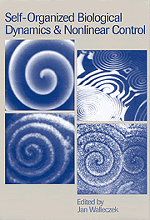 Self-Organized Biological Dynamics and Nonlinear Control
Self-Organized Biological Dynamics and Nonlinear Control Published online by Cambridge University Press: 14 August 2009
Introduction
A particle in solution is subject to random collisions with solvent molecules, giving rise to the erratic, ‘Brownian’, motion first observed and reported by Robert Brown in 1826. This dynamic behavior was described theoretically by Langevin (1908), who hypothesized that the forces on the particle due to the solvent can be split into two components: (1) a fluctuating force that changes magnitude and direction very frequently compared to any other time scale of the system, and (2) a viscous drag force that always acts to slow the motion induced by the fluctuation term. Einstein (1906) derived a (fluctuation–dissipation) relationship between the magnitude of the fluctuation term and the viscous drag coefficient that dampens its effect. Since the strength of the fluctuation increases with temperature, the fluctuating force is often called thermal noise. If the particle is a molecule, bombardment by the solvent also allows exploration of the different molecular configurations, i.e., the arrangements of the atoms of the molecule relative to each other. Biological (and many other) macromolecules often have only a few stable configurations, called conformations, with large energy barriers separating them. Thermal noise ‘activates’ transitions over these barriers from one conformation to another. Kramers (1940) formulated a theory for thermal noise-activated transitions between different conformations based on diffusion over energy barriers (e.g., Hänggi et al., 1990).
To save this book to your Kindle, first ensure [email protected] is added to your Approved Personal Document E-mail List under your Personal Document Settings on the Manage Your Content and Devices page of your Amazon account. Then enter the ‘name’ part of your Kindle email address below. Find out more about saving to your Kindle.
Note you can select to save to either the @free.kindle.com or @kindle.com variations. ‘@free.kindle.com’ emails are free but can only be saved to your device when it is connected to wi-fi. ‘@kindle.com’ emails can be delivered even when you are not connected to wi-fi, but note that service fees apply.
Find out more about the Kindle Personal Document Service.
To save content items to your account, please confirm that you agree to abide by our usage policies. If this is the first time you use this feature, you will be asked to authorise Cambridge Core to connect with your account. Find out more about saving content to Dropbox.
To save content items to your account, please confirm that you agree to abide by our usage policies. If this is the first time you use this feature, you will be asked to authorise Cambridge Core to connect with your account. Find out more about saving content to Google Drive.